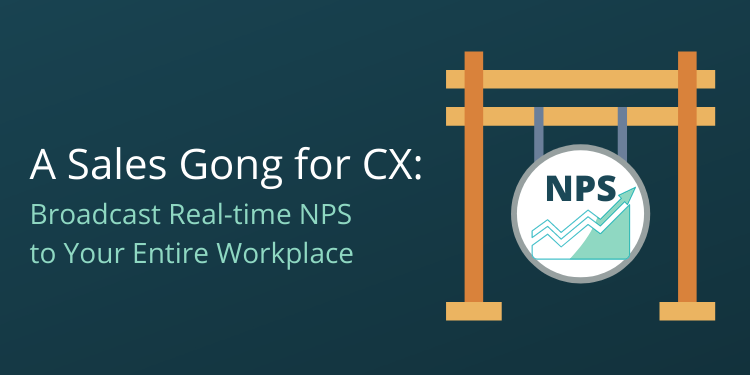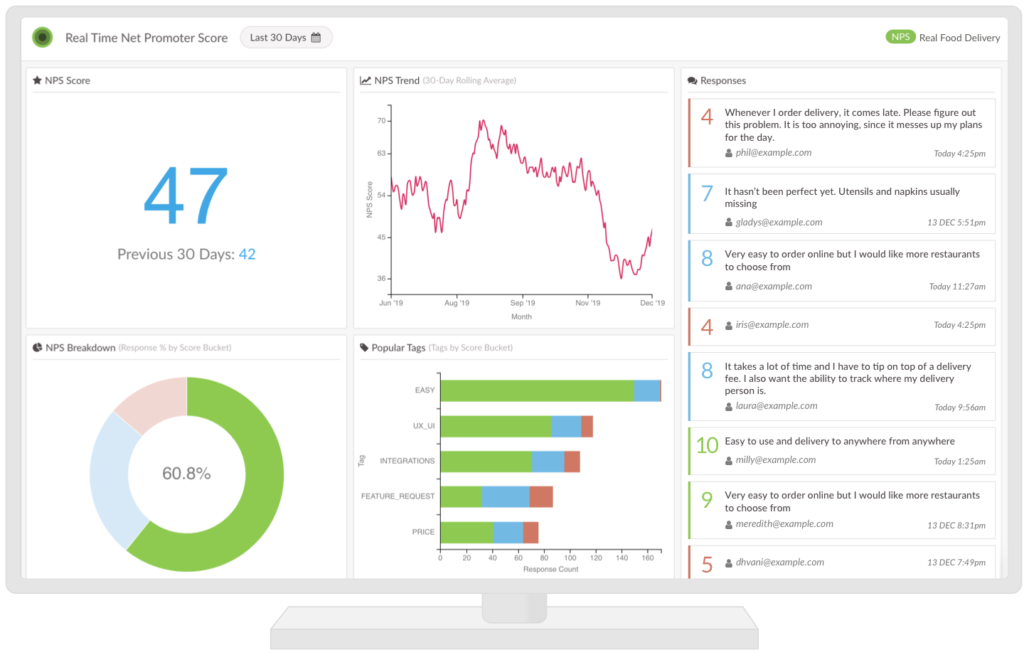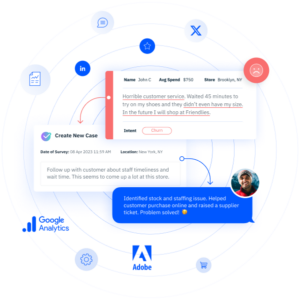A Sales Gong for CX : Broadcast Real-time NPS to Your Entire Workplace

The sales gong is a motivational technique used on sales floors around the world. Every time someone closes a deal, they bang a gong or ring a bell to celebrate their success. And when the office gets quiet? Everyone knows it’s time to hustle.
In other words, there’s never any question about how the team is doing at any given moment, and the constant feedback gets the entire sales force aligned in their mission to sell, sell, sell.
Now… imagine doing the same thing, for your entire organization, regarding Customer Experience (CX)? Rather than a sales gong, picture a TV monitor that broadcasts real-time customer feedback and Net Promoter Scores (NPS), getting everyone from accounting to operations aligned in the mission to turn customers into raving fans.
Broadcasting real-time NPS data will help you build a customer-centric culture, which ultimately leads to greater customer loyalty and powerful returns.
What is a Net Promoter Score (NPS)?
Measuring your Net Promoter Score is relatively straightforward. An NPS survey asks your customers to rate, on a scale of 0-10, how likely they are to recommend your company, products, or services to a friend or colleague.
Responses are then grouped into:
- Detractors (those who responded 0-6)
- Neutrals (7-8)
- Promoters (9-10)
To determine your Net Promoter Score, subtract your percentage of promoters from your percentage of detractors.
NPS = (% Promoters – % Detractors)
Example: You survey 500 customers, asking how likely they are to recommend your company to friends or colleagues. 50 respondents (10%) answered 0-6, another 100 (20%) answered 7-8, and 350 (70%) answered 9 or 10.
Your Company’s NPS is 70% – 10% = 60.
The Net Promoter Survey is then followed by one of the following open-ended questions (depending on their answer):
- “What can we do to improve?” (those who rates you 0-8)
- “What did you love about your experience? (those who rated you 9-10)
Why does NPS matter?
The correlation between revenue and CX is solid. And, NPS is the foundational metric that can serve as a north star on the journey to customer-centricity and the growth that comes with it. However… simply gathering feedback and measuring NPS gets your nowhere.
The real power of NPS comes from the system you build around it. This means:
- Closing the loop with customers (i.e., fixing the problem, thanking them for their feedback).
- Analyzing responses to prioritize improvements to products and services.
- Using NPS to create a more customer-centric culture.
Only then does NPS help you retain more customers and drive growth.
In a custom-centric company, the Success and Support teams works diligently to close the loop with customers, the Product team analyzes the data to create superior products, and Marketing crafts their messaging to educate and answer objections before they arise.
As for shifting company culture? That’s a job for the CEO or a C-Suite sponsor of your NPS program (often with the support of the VP or Director of Customer Experience).
Creating a more customer-centric culture with NPS
Culture change is a multifaceted undertaking, but you can anchor it with your NPS program. Evangelize NPS as a Key Performance Indicator (KPI), right alongside revenue, churn, and other important figures.
What does evangelizing NPS look like?
- Educate everyone (from new hires to the board) about why NPS is important to customer experience management.
- Share the results of NPS surveys in company newsletters and quarterly board decks.
- Don’t just share the score by itself. Include customer comments and NPS trends by customer segment.
Where reports and memos fall short
Unfortunately, in between those quarterly reports, NPS can get lost. Unlike the Sales gong that keeps everyone on the floor tuned into customer acquisition as a Key Performance Indicator, NPS can be out of sight and out of mind.
And that’s where a real-time display of NPS feedback comes in. You can bridge that gap between reporting cycles when you display your evolving NPS live, on a monitor, along with raw customer feedback.

4 Reasons to broadcast real-time NPS and feedback in the office
If your goal is to create a more customer centric company and reap the benefits of a high NPS, an “NPS TV” can help unite everyone on that mission in the following ways.
1. Reinforce awareness of NPS as a KPI.
Certain KPI’s are more obvious than others. Revenue, profit, and conversions get a lot of airtime, but NPS is easy to ignore unless you put it front and center.
In reality, everyone should be thinking about NPS if you want to drive growth!
2. Build empathy with the customer.
There is nothing quite like seeing the latest comments from active customers appearing on screen. Overjoyed, frustrated, curt, complimentary—it’s the emotions in the verbatim comments that humanize your customers and creates a connection to their experience. For more tips, check out these ways to build customer empathy.
3. Reach departments that don’t normally engage with customers.
The customer success team lives and breathes NPS because it’s an early indicator of churn. But the finance team? Not so much. At customer-centric companies, everyone understands their responsibility for customer loyalty.
Set up the monitor in a prominent place. It could be on a wall everyone sees as they come in or out of the office, opposite the coffee machine, or in any hub in the workplace.
That way more people are likely to read customer comments and tune into NPS trends.
4. Invest in an easy, low-cost enhancement to your NPS program.
For the cost of a computer and a monitor, you’ll be in business in minutes—and that’s a small price to pay if you are after customer experience transformation. As far as NPS tools go, it’s one of the cheapest and most effective ones on the market.
Note: For remote teams, a monitor doesn’t work. What to do? Create an NPS Slack channel! Click here to learn how to use Slack and NPS date to build customer-centricity.
Customer centricity… and beyond!
Your customers are the lifeblood of your business, but unless an employee’s job is customer-facing, it’s easy to lose sight of what your customers are going through. Making everyone aware of NPS brings the customer experience into stark relief, and it unites everybody in a single, all-important mission.
Remember: Net Promoter Score has a solid impact on revenue, and it’s the single best metric for predicting long-term growth and success—when you build a customer-centric culture around it. If you can involve everyone with creating a positive, seamless customer experience, your NPS score will rise and your revenues will soar.
Learn how InMoment can help you measure and improve customer experience. Book a consultative demo today.
